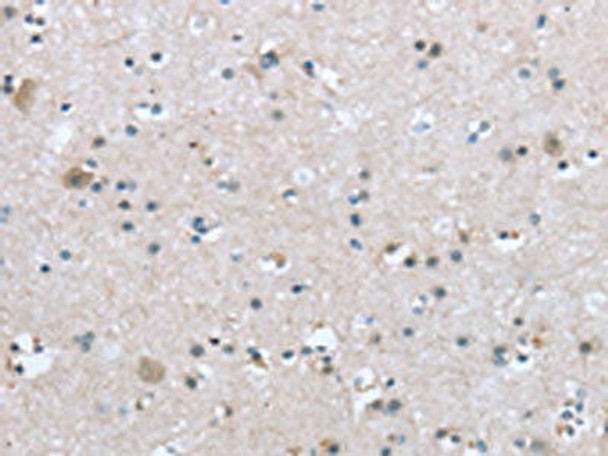Description
| Antibody Name: | TRPM3 Antibody (PACO20765) |
| Antibody SKU: | PACO20765 |
| Size: | 50ul |
| Host Species: | Rabbit |
| Tested Applications: | ELISA, IHC |
| Recommended Dilutions: | ELISA:1:1000-1:2000, IHC:1:10-1:50 |
| Species Reactivity: | Human |
| Immunogen: | Synthetic peptide of human TRPM3 |
| Form: | Liquid |
| Storage Buffer: | -20°C, pH7.4 PBS, 0.05% NaN3, 40% Glycerol |
| Purification Method: | Antigen affinity purification |
| Clonality: | Polyclonal |
| Isotype: | IgG |
| Conjugate: | Non-conjugated |
 | The image on the left is immunohistochemistry of paraffin-embedded Human brain tissue using PACO20765(TRPM3 Antibody) at dilution 1/20, on the right is treated with synthetic peptide. (Original magnification: x200). |
| Background: | The product of this gene belongs to the family of transient receptor potential (TRP) channels. TRP channels are cation-selective channels important for cellular calcium signaling and homeostasis. The protein encoded by this gene mediates calcium entry, and this entry is potentiated by calcium store depletion. Alternatively spliced transcript variants encoding different isoforms have been identified. |
| Synonyms: | transient receptor potential cation channel, subfamily M, member 3 |
| UniProt Protein Function: | TRPM3: a transient receptor potential (TRP) ion channel. Mediates constitutive calcium ion entry. Its activity is increased by reduction in extracellular osmolarity, by calcium store depletion and muscarinic receptor activation. TRP voltage-independent calcium-permeable cation channels are divided into six subfamilies, two of which (TRPC and TRPM) have members that are widely expressed. Ten alternatively spliced isoforms have been described.Protein type: Channel, cation; Membrane protein, integral; Membrane protein, multi-passChromosomal Location of Human Ortholog: 9q21.12-q21.13Cellular Component: integral component of membrane; plasma membraneMolecular Function: calcium activated cation channel activity; calcium channel activity; cation channel activityBiological Process: cation transport; detection of temperature stimulus; protein tetramerization; sensory perception of temperature stimulus |
| UniProt Protein Details: | |
| NCBI Summary: | The product of this gene belongs to the family of transient receptor potential (TRP) channels. TRP channels are cation-selective channels important for cellular calcium signaling and homeostasis. The protein encoded by this gene mediates calcium entry, and this entry is potentiated by calcium store depletion. Alternatively spliced transcript variants encoding different isoforms have been identified. [provided by RefSeq, Jul 2008] |
| UniProt Code: | Q9HCF6 |
| NCBI GenInfo Identifier: | 581985920 |
| NCBI Gene ID: | 80036 |
| NCBI Accession: | AHI18585.1 |
| UniProt Secondary Accession: | Q9HCF6,Q5VW02, Q5VW03, Q5VW04, Q5W5T7, Q86SH0, Q86SH6 Q86UL0, Q86WK1, Q86WK2 |
| UniProt Related Accession: | Q9HCF6 |
| Molecular Weight: | 25,159 Da |
| NCBI Full Name: | transient receptor potential cation channel subfamily M member 3, partial |
| NCBI Synonym Full Names: | transient receptor potential cation channel subfamily M member 3 |
| NCBI Official Symbol: | TRPM3 |
| NCBI Official Synonym Symbols: | GON-2; MLSN2; LTRPC3 |
| NCBI Protein Information: | transient receptor potential cation channel subfamily M member 3 |
| UniProt Protein Name: | Transient receptor potential cation channel subfamily M member 3 |
| UniProt Synonym Protein Names: | Long transient receptor potential channel 3; LTrpC-3; LTrpC3; Melastatin-2; MLSN2 |
| Protein Family: | Transient receptor potential cation channel subfamily |
| UniProt Gene Name: | TRPM3 |
| UniProt Entry Name: |






